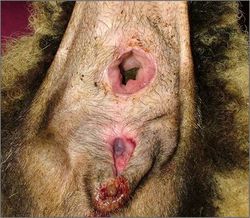Difference between revisions of "Anus - Anatomy & Physiology"
Fiorecastro (talk | contribs) |
m (Text replace - "Category:To Do - Review" to "Category:To Do - AP Review") |
||
| (6 intermediate revisions by 3 users not shown) | |||
| Line 1: | Line 1: | ||
| − | |||
==Overview== | ==Overview== | ||
| Line 17: | Line 16: | ||
===Carnivore=== | ===Carnivore=== | ||
| − | The dog and cat posses two '''anal sacs'''. In the dog, these are the size of a hazlenut. They are located ventrolaterally between the internal and external anal sphincters. They are large, coiled apocrine tubules that have many '''tubuloalveolar glands''' in their walls. These '''tubuloalveolar glands''' produce a fatty secretion. The '''fundus''' of the sac secretes a potent smelling fluid that drains through a single duct to an opening near the '''anocutaneous | + | The dog and cat posses two '''anal sacs'''. In the dog, these are the size of a hazlenut. They are located ventrolaterally between the internal and external anal sphincters. They are large, coiled apocrine tubules that have many '''tubuloalveolar glands''' in their walls. These '''tubuloalveolar glands''' produce a fatty secretion. The '''fundus''' of the sac secretes a potent smelling fluid that drains through a single duct to an opening near the '''anocutaneous juncntion'''. |
| − | |||
The anal sacs get compressed during defecation, which causes the fluid to be expressed. The scent of the fluid is thought to act as a territorial marker. | The anal sacs get compressed during defecation, which causes the fluid to be expressed. The scent of the fluid is thought to act as a territorial marker. | ||
| − | + | Anal sacs are clinically important as they are commonly diseased in dogs - frequently, they become enlarged due to accumulated secretion. The '''dog''' has '''perianal glands''' that lie in the skin surrounding the anus. They are modified sebaceous glands. | |
| − | Anal sacs are clinically important as they are commonly | ||
===Equine=== | ===Equine=== | ||
| − | Click here for information on the [[Alimentary System - | + | Click here for information on the [[Equine Alimentary System - Anatomy & Physiology|equine]] anus. |
===Porcine=== | ===Porcine=== | ||
Also have '''anal sacs'''. | Also have '''anal sacs'''. | ||
| − | |||
| − | |||
| − | |||
| − | |||
| − | |||
| − | |||
| − | |||
| − | |||
| − | |||
| − | |||
| − | |||
| − | |||
| − | |||
| − | |||
| − | |||
| − | |||
| − | |||
==Links== | ==Links== | ||
| − | '''Click here for information on the [[Intestines, Small and Large - Pathology| | + | '''Click here for information on the[[Intestines, Small and Large - Pathology|pathology Of The Small and Large Intestines]].''' |
| + | '''Click here for [[Anus - Histology|anus histology]].''' | ||
[[Category:Large Intestine - Anatomy & Physiology]] | [[Category:Large Intestine - Anatomy & Physiology]] | ||
| − | [[Category: | + | [[Category:To Do - AimeeHicks]][[Category:To Do - AP Review]] |
Revision as of 12:14, 18 October 2010
Overview
The anus is the terminal portion of the alimentary tract which communicates with the external environment. Two sphincters control it's aperture. It allows faeces and gas to leave the body. Defeacation is the process where faeces are expelled from the rectum through the anus.
Structure
There are two anal sphincters: The internal anal sphincter, formed by the thickening of the circular smooth muscle of the gut and under autonomic control and the external anal sphincter, formed from striated skeletal muscle and under voluntary control.
Function
The function of the anus is to transmit faeces from the rectum to the external environment. Anal sphincters give control over the regularity of defeaction, and this may be consciously controlled in some species. The anal canal lubricates the passage of faeces.
Species Differences
Carnivore
The dog and cat posses two anal sacs. In the dog, these are the size of a hazlenut. They are located ventrolaterally between the internal and external anal sphincters. They are large, coiled apocrine tubules that have many tubuloalveolar glands in their walls. These tubuloalveolar glands produce a fatty secretion. The fundus of the sac secretes a potent smelling fluid that drains through a single duct to an opening near the anocutaneous juncntion. The anal sacs get compressed during defecation, which causes the fluid to be expressed. The scent of the fluid is thought to act as a territorial marker. Anal sacs are clinically important as they are commonly diseased in dogs - frequently, they become enlarged due to accumulated secretion. The dog has perianal glands that lie in the skin surrounding the anus. They are modified sebaceous glands.
Equine
Click here for information on the equine anus.
Porcine
Also have anal sacs.
Links
Click here for information on thepathology Of The Small and Large Intestines.
Click here for anus histology.
